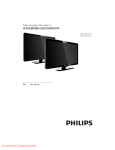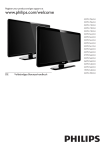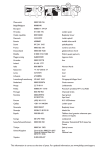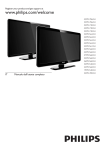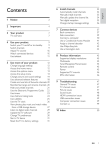Download Philips 22HFL3381D/10 Flat Panel Television User Manual
Transcript
Register your product and get support at www.philips.com/welcome 22HFL3381D/10 26HFL3381D/10 EN User Manual Notice ݱ²¹®¿¬«´¿¬·±²- ©·¬¸ ¬¸·- ²»© ¸±-°·¬¿´·¬§ ¬»´»ª·-·±² -»¬ò ײ ¬¸·- Ë-»® Ó¿²«¿´ ·¬ -±³»¬·³»- ¸¿°°»² ¬¸¿¬ ¬¸» ®»³¿®µ ùѲ´§ ¿ª¿·´¿¾´» ±² ½±²-«³»® ®»³±¬» ½±²¬®±´ùò ̸·- ³»¿²- ¬¸¿¬ ¬¸» ³»²¬·±²»¼ ¿½¬·±² ·- ²±¬ ¿½½»-·¾´» ª·¿ ¬¸» ·²½´«¼»¼ ¸±-°·¬¿´·¬§ ®»³±¬» ½±²¬®±´ øîîßÊïïðìñïð÷ò ׺ ²»»¼»¼ô ¿ ½±²-«³»® ®»³±¬» ·- ·²½´«¼»¼ ¿- ©»´´ ¿²¼ §±« ½¿² «-» ¬¸·- ·º ²»»¼»¼ò ß´¬¸±«¹¸ ¬¸» ½±²-«³»® ®»³±¬» ·- ·²½´«¼»¼ô ·¬ ·- º±®»-»»² ¬± ¾» «-»º«´ º±® -±³» ·²-¬¿´´¿¬·±² °«®°±-» ±²´§ ø¿- »¨¿³°´»æ ®»ó±®¼»® ½¸¿²²»´-÷ô ¬¸» ¸±-°·¬¿´·¬§ ®»³±¬» ©·´´ -»®ª» ¬¸» ¹«»-¬ ¾»-¬ò ر-°·¬¿´·¬§ λ³±¬» ݱ²¬®±´ ݱ²-«³»® λ³±¬» ݱ²¬®±´ Ó±¼»´ Í»®·¿´ ©©©ò°¸·´·°-ò½±³ñ-«°°±®¬ Österreich 0810 000205 0.07 pro Minute België/Belgique 078250145 0.06 Per minuut/Par minute +3592 489 99 96 Hrvatska eská republika 01 6403 776 Lokalni poziv 800142840 Bezplatný hovor Danmark 3525 8759 Lokalt opkald Estonia 6008600 local Suomi 09 2311 3415 paikallispuhelu France 0821 611655 0.09 Par minute Deutschland 01803 386 852 0.09 pro Minute 0 0800 3122 1280 Magyarország 0680018189 Ingyenes hívás Ireland North 0800 055 6882 South 1800-PHILIPS 7445477 free Italia 840320086 0.08 Al minuto +7 727 250 66 17 local Latvia 52737691 local Lithuania 67228896 local Luxemburg/Luxembourg 40 6661 5644 Ortsgespräch/Appel local Nederland 0900 8407 0.10 Per minuut Norge 2270 8111 Lokalsamtale Polska (022) 3491504 po czenie lokalne Portugal 800 780 903 Chamada local 021-203-2060 Apel local România Moscow (495) 961-1111 Outside Moscow 8-800-200-0880 +381 114 440 841 Lokalni poziv Slovensko 0800 004537 Bezplatný hovor Slovenija 01 280 95 22 lokalni klic España 902 888 784 0.10 Por minuto Sverige 08 5792 9100 Lokalsamtal Suisse/Schweiz/Svizzera 0844 800 544 Appel local/Ortsgespräch/Chiamata locale Türkiye 0800 261 3302 United Kingdom 0845-6010354 ehiriçi arama local 8-800-500-69-70 This information is correct at the time of press. For updated information, see www.philips.com/support. Contents 7 Professional mode instruction 1 Notice 2 2 Important 4 3 TV overview 6 Side controls and indicators Guest remote control 4 Use your product Switch your TV on/off or to standby Switch channels Watch connected devices Adjust TV volume Use Teletext 5 Use more of your product Access TV menus Remove devices from the home menu Change picture and sound settings Use advanced Teletext features Use the Electronic Programme Guide Use Timers Use subtitles Use the TV clock View photos and play music from a USB storage device Listen to digital radio channels Update the TV software Change TV preferences Access decoder channel Start a TV DEMO Reset the TV to factory settings 6 Install channels Automatically install channels Manually install channels Rename channels Reorder channels Test digital reception 24 Introduction 6 6 8 8 8 9 9 9 10 10 10 10 13 14 14 15 16 17 18 18 19 19 20 20 24 4 Professional Setup Remote control (2573 optional) 24 Activating the Professional mode setup menu 25 Professional mode options 26 8 Connect devices 34 Back connector for 22 inch TV Back connector for 26 inch TV and larger Side connector Connect a computer Use a Conditional Access Module Use Philips EasyLink Use a Kensington lock 9 Product information 34 36 37 38 39 40 40 41 Supported display resolutions Multimedia Tuner/Reception/Transmission Remote control Power Supported TV mounts 41 41 41 41 41 41 10 Troubleshooting 42 General TV issues TV channel issues Picture issues Sound issues HDMI connection issues Computer connection issues Contact us 42 42 42 43 43 43 43 21 21 22 23 23 23 EN 1 1 Notice 2009 © Koninklijke Philips Electronics N.V. All rights reserved. notice. Trademarks are the property of Koninklijke Philips Electronics N.V or their respective owners. Philips reserves the right to change products at any time without being obliged to adjust earlier supplies accordingly. The material in this manual is believed adequate for the intended use of the system. If the product, or its individual modules or procedures, are used for purposes other than validity and suitability must be obtained. Philips warrants that the material itself does not infringe any United States patents. No further warranty is expressed or implied. Warranty Risk of injury, damage to TV or void of warranty! Never attempt to repair the TV yourself. Use the TV and accessories only as intended by the manufacturer. The caution sign printed on the back of the TV indicates risk of electric shock. Never remove the TV cover. Always contact Philips Customer Support for service or repairs. Any operation expressly prohibited in this manual, or any adjustments and assembly procedures not recommended or authorised in this manual shall void the warranty. Pixel characteristics This LCD product has a high number of colour pixels. Although it has effective 2 EN pixels of 99.999% or more, black dots or bright points of light (red, green or blue) may appear constantly on the screen. This is a structural property of the display (within common industry standards) and is not a malfunction. Open source software This television contains open source software. Philips hereby offers to deliver or make available, upon request, for a charge no more than the cost of physically performing source distribution, a complete machine-readable copy of the corresponding source code on a medium customarily used for software interchange. This offer is valid for a period of 3 years after the date of purchase of this product. To obtain the source code, write to: GBU Customer Care Manager Customer Care department Philips Lighting GBU Hospitality Hurksestraat 2c 5652 AJ Eindhoven The Netherlands Compliance with EMF Koninklijke Philips Electronics N.V. manufactures and sells many products targeted at consumers which, like any electronic apparatus, in general have the ability to emit and receive electromagnetic signals. One of Philips’ leading Business Principles is to take all necessary health and safety measures for our products, to comply with all applicable legal requirements and to stay well within the EMF standards applicable at the time of producing the products. Philips is committed to develop, produce and market products that cause no that if its products are handled properly for their intended use, they are safe available today. Philips plays an active role in the development of international EMF and safety standards, enabling Philips to anticipate further developments in standardisation for early integration in its products. Mains fuse (UK only) 1 2 3 moulded plug. Should it become necessary to replace the mains fuse, this must be replaced with a fuse of the same value as indicated on the plug (example 10A). Note Only applicable to TVs supporting MPEG4-HD standard All other registered and unregistered trademarks are the property of their respective owners. Remove fuse cover and fuse. The replacement fuse must comply with BS 1362 and have the ASTA approval mark. If the fuse is lost, contact your dealer in order to verify the correct type. In order to maintain conformity to the EMC directive, the mains plug on this product must not be detached from the mains cord cable. Copyright VESA, FDMI and the VESA Mounting Compliant logo are trademarks of the Video Electronics Standards Association. ® Kensington and Micro Saver are registered US trademarks of ACCO World Corporation with issued registrations and pending applications in other countries throughout the world. Manufactured under licence from Dolby Laboratories. Dolby and the double-D symbol are trademarks of Dolby Laboratories. EN 3 2 Important Read and understand all instructions before you use your TV. If damage is caused by failure to follow instructions, the warranty does not apply. Safety Never expose the TV to rain or water. Never place liquid containers, such as vases, near the TV. If liquids are spilt on or into the TV, disconnect the TV from the power outlet immediately. Contact Philips Consumer Care to have the TV checked before use. Never place the TV, remote control other heat sources, including direct sunlight. the TV, remote control and batteries at all times. Never insert objects into the ventilation slots or other openings on the TV. When the TV is swivelled ensure that no strain is exerted on the power cord. Strain on the power cord can loosen connections and cause arcing. Never expose the remote control or batteries to rain, water or excessive heat. Avoid force coming onto power plugs. Loose power plugs can cause arcing Risk of injury or damage to the TV! 4 EN Two people are required to lift and carry a TV that weighs more than 25 kg. When stand mounting the TV, use only the supplied stand. Secure the stand to the TV tightly. Place the support the combined weight of the TV and the stand. When wall mounting the TV, use only a wall mount that can support the weight of the TV. Secure the wall mount to a wall that can support the combined weight of the TV and wall mount. Koninklijke Philips Electronics N.V. bears no responsibility for improper wall mounting that result in accident, injury or damage. Risk of injury to children!Follow these precautions to prevent the TV from toppling over and causing injury to children: Never place the TV on a surface covered by a cloth or other material that can be pulled away. Ensure that no part of the TV hangs over the edge of the surface. Never place the TV on tall furniture (such as a bookcase) without anchoring both the furniture and TV to the wall or a suitable support. Educate children about the dangers of climbing on furniture to reach the TV. Risk of overheating! Never install the TV of at least 4 inches or 10 cm around the TV for ventilation. Ensure curtains or other objects never cover the ventilation slots on the TV. Risk of damage to the TV! Before you connect the TV to the power outlet, ensure that the power voltage matches the value printed on the back of the TV. Never connect the TV to the power outlet if the voltage is different. Never place the TV or any objects on the power cord. To easily disconnect the TV power cord from the power outlet, ensure that you have full access to the power cord at all times. When you disconnect the power cord, always pull the plug, never the cable. Disconnect the TV from the power outlet and aerial before lightning storms. During lightning storms, never touch any part of the TV, power cord or aerial cable. Risk of hearing damage! Avoid using earphones or headphones at high volumes or for prolonged periods of time. If the TV is transported in temperatures below 5°C, unpack the TV and wait until the TV temperature matches room temperature before connecting the TV to the power outlet. Screen care Avoid stationary images as much as possible. Stationary images are images that remain on-screen for extended periods of time. Examples include: on-screen menus, black bars and time displays. If you must use stationary images, reduce screen contrast and brightness to avoid screen damage. Unplug the TV before cleaning. Clean the TV and frame with a soft, damp cloth. Never use substances such asalcohol, chemicals or household cleaners on the TV. Risk of damage to the TV screen! Never touch, push, rub or strike the screen with any object. To avoid deformations and colour fading, wipe off water drops as soon as possible. Disposal of your old product and batteries Your product is designed and manufactured with high quality materials and components, which can be recycled and reused. When this crossed-out wheeled bin symbol is attached to a product it means that the product is covered by the European Directive 2002/96/EC. Please inform yourself about the local separate collection system for electrical and electronic products. Please act according to your local rules and do not dispose of your old products with your normal household waste. Correct disposal of your old product helps to prevent potential negative consequences for the environment and human health. Your product contains batteries covered by the European Directive 2006/66/EC, which cannot be disposed with normal household waste. Please inform yourself about the local rules on separate collection of batteries because correct disposal helps to prevent negative consequences for the environmental and human health. EN 5 3 TV overview This section gives you an overview of commonly used TV controls and functions. Please read section 3 to 6 to set the basic instructions in section 7 to set the Professional mode menu. Guest remote control ¿ « ¾ ¬ ½ ¼ ® » º Side controls and indicators ¯ ¹ ¸ ° · ¶ ± µ ´ a POWER: Switches the product on or off. The product is not powered off completely unless it is physically unplugged. b P/CH +/-: Switches to the next or previous channel. c SOURCE: Selects connected devices. d VOLUME +/-: Increases or decreases volume. 6 EN ² ³ a Þ (Standby-On) Switches the TV to standby if the TV is on. Switches the TV on if the TV is in standby b ¿GUIDE Switches between channel grid and programme list. c SUBTITLE Launches the subtitle menu. d AV Selects connected devices. e p MENU / EXIT ÒÑ ÙËÛÍÌ ÓÛÒË q Colour buttons Selects tasks or options. When Professional mode is On, press to operate Multi remote control function. (See page 33 “Multi remote control”). r Red button(DEMO) Toggles the demonstration menu on or off. (Only applicable in [Signage] mode, or Professional mode is set to Off ). ÒÑ ÚËÒÝÌ×ÑÒ s Blue button (Audio Descriptor) (For RF Digital TV only) UK only: Enables audio commentary for the visually handicapped. ÒÑ ÚËÒÝÌ×ÑÒ t TELETEXT Toggles Teletext on or off. f g OK Press to display the channel grid, when watching TV. h o Œ+/- (Volume +/-) Increases or decreases volume. (Navigation buttons) Navigates through the menus. i SLEEP ÒÑ ÚËÒÝÌ×ÑÒ u ¾(OPTION) ÒÑ ÚËÒÝÌ×ÑÒ Note modes. j t (MUTE) Mutes or restores audio output. k P+/- (Programme +/-) Switches to the next or previous channel. When the TV menu is on, this functions as Page Up/Down. l 0-9 (Numeric buttons) Selects a channel or setting. m (Picture format) Launches the picture format menu. n MHEG / CANCEL UK only: Enables audio commentary for the visually handicapped. EN 7 4 Use your product Note If you cannot locate your remote control and want to switch on the TV from standby, press P/CH +/- or SOURCE at the side of the TV. This section helps you perform basic operations Switch your TV on/off or to standby To switch on If the standby indicator is off, press POWER at the side of the TV. If the standby indicator is red, press (Standby-On) on the remote control. To switch to standby Press (Standby-On) on the remote control. » The standby indicator switches to red. To switch off Press POWER at the side of the TV. » The standby indicator switches off. Tip Though your TV consumes very little power when in standby, energy continues to be consumed. When not in use for an extended period of time, disconnect the TV power cable from the power outlet. 8 EN Switch channels Press P +/- on the remote control or P / CH +/- on the side of the TV. Enter a channel number using the Numeric buttons. Use the channel grid. Note When you use a favourite list, you can only select those channels in the list. Watch connected devices Note Switch on the device before selecting it as a source on the TV. To mute or unmute sound Press to mute the sound. Press again to restore the sound. Use Teletext Use the AV button 1 1 2 3 Press AV. » The source list appears. 2 Press the Navigation buttons to select a device. Press OK » The TV switches to the selected device. Adjust TV volume 3 Press TELETEXT. » The main index page appears. Select a page as follows: Press the Numeric buttons to enter a page number Press P +/- or to view the next or previous page Press the Colour buttons to select a colour coded item Press TELETEXT to exit Teletext. Note For UK users only: Some digital TV channels offer dedicated digital text services (for example, BBC1).v To increase or decrease volume Press +/-. Press VOLUME +/- on the side of the TV. EN 9 5 Use more of your product Remove devices from the home menu øѲ´§ ¿ª¿·´¿¾´» ±² ½±²-«³»® ®»³±¬» ½±²¬®±´÷ If a device is no longer connected to the TV, remove it from the home menu. Access TV menus Menus help you to install channels, change picture and sound settings and access other features. 1 Press MENU. » The menu screen appears. ß¼¼ ²»© ¼»ª·½» 1 2 3 4 Press MENU Press to select a device to remove. (OPTIONS) Press . » The [Remove device] list appears. Press OK and select [Remove] to remove the device. » The selected device is removed from the home menu. Í»¬«° É¿¬½¸ ÌÊ Change picture and sound settings Change picture and sound settings to suit your 2 3 4 or change settings manually. Press the to select and navigate through one of the following menus. [Watch TV]Switches back to the aerial source if another source is selected. [Setup]Accesses menus that allow you to change picture, sound and other TV settings. [Add new device]Adds new devices to the home menu. Use Settings assistant Use the Settings assistant to guide you through the best picture and sound settings. 1 2 3 Press OK Press EXIT to exit. Tip After selecting [Add new device], follow the on-screen instructions to select the correct device and connector. EN to select [Setup] > [Picture] Press > [Settings assistant]. Press OK. » The [Settings assistant] menu appears. Follow the on-screen instructions to choose your preferred picture settings. Use Smart picture picture settings. 1 2 10 Press MENU. Press MENU. to select [Setup] > [Picture] Press > [Smart picture]. 3 4 Press to select one of the following Smart picture settings. [Personal] Lists customised personal picture settings. [Vivid] Maximises picture settings. [Standard] Adjusts picture settings to suit most environments and types of video. [Movie] Applies picture settings ideally suited for movie viewing. [Game] Applies picture settings maximised for fast-moving games. [Energy saving] Applies low-energy picture settings. Press OK » The selected Smart picture setting is applied. Manually adjust Picture settings 1 2 Press MENU. Press [Picture]. з½¬«®» ͱ«²¼ to select [Setup] > Í»¬¬·²¹- ¿--·-¬ò ß½¬·±² ͳ¿®¬ °·½¬«®» л®-±²¿´ ݱ²¬®¿-¬ Þ®·¹¸¬²»-- Ú»¿¬«®»Ý±´±«® ײ-¬¿´´¿¬·±² Ø«» ͸¿®°²»-- ͱº¬©¿®» «°¼¿¬» 3 Ò±·-» ®»¼«½¬·±² Ѻº to select one of the Press following picture settings. [Smart picture] smart picture settings. [Contrast] Adjusts the intensity of bright areas, keeping dark areas unchanged. [Brightness] Adjusts the intensity and details of dark areas. [Colour] Adjusts colour saturation. [Hue] Compensates colour variations in NTSC encoded transmissions. [Sharpness] Adjusts the level of sharpness in image details. [Noise reduction] Filters and reduces noise in an image. [Tint] Adjusts the colour balance in an image. [Custom tint] Make a customised tint setting. (Only available if [Tint] > [Custom] is selected) [Digital Crystal Clear] Fine-tunes each pixel to match surrounding pixels. This [Dynamic contrast] Automatically enhances contrast in an image. A [Medium] setting is recommended. [Dynamic backlight] Adjusts the brightness of the TV backlight to match lighting conditions. [MPEG artifact reduction] Smoothes out transitions on digital pictures. You can switch this feature on or off. [Colour enhancement] Makes colours more vivid and improves the resolution of details in bright colours. You can switch this feature on or off. [PC mode] Adjusts the picture when a PC is connected to the TV via HDMI or DVI. [Picture format] Changes the picture format. [Horizontal shift] Adjusts the picture horizontally for PC-VGA, DVI, HDMI or YPbPr. [Vertical shift] Adjusts the picture vertically for PC-VGA, DVI, HDMI or YPbPr. EN 11 Change picture format 1 2 3 [Wide screen]Stretches the classic 4:3 format to 16:9. Press . » A picture format bar appears. [Unscaled]For HD and PC mode only, and in selected models only. Allows maximum sharpness. Some distortion may be present due to the broadcaster’s systems. Set your PC resolution to wide screen mode for best results. Press or to select a picture format. » The selected picture format is activated. Press OK Summary of picture formats The following picture settings can be Note Depending on the format of the picture source, some picture settings are not available. [Auto format](Not for PC mode.) Enlarges the picture automatically to settings. subtitles remain visible. [Super zoom](Not for HD and PC mode.) Removes the black bars on the side of 4:3 broadcasts. There is minimal distortion. [4:3]Shows the classic 4:3 format. 3 [Subtitle zoom]Displays 4:3 pictures over the full area of the screen, with sub-titles visible. Part of the top of the picture is clipped off. [Movie expand 14:9](Not for HD and PC mode.) Scales 4:3 format to 14:9. [Movie expand 16:9](Not for HD and PC mode.) Scales 4:3 format to 16:9. 12 EN Use Smart sound 1 2 4 Press MENU. to select [Setup] > [Sound] Press > [Smart sound]. Press to select one of the following Smart sound settings. [Standard] Adjusts sound settings to suit most environments and types of audio. [News] Applies sound settings ideally suited for spoken audio, such as the news. [Movie] Applies sound settings ideally suited for movies. [Personal] Applies the settings that were customised in the sound menu. Press OK » The selected Smart sound setting is applied. Adjust sound settings 1 2 Press MENU. to select [Setup] > [Sound]. Press » The [Sound] menu appears. з½¬«®» ͳ¿®¬ -±«²¼ [Headphone volume] Adjusts headphone volume. (Only appears when Professional mode is [Off]) [Auto volume] Automatically reduces sudden volume changes, for example, when switching channels. When enabled, this produces a more consistent audio volume. [Delta volume] Levels out volume differences between channels or connected devices. Switch to the connected device before you change the delta volume. ͬ¿²¼¿®¼ Þ¿-ͱ«²¼ Ì®»¾´» ʱ´«³» Ú»¿¬«®»Ê±´òª·-ò·³°¿·®»¼ ײ-¬¿´´¿¬·±² ͱº¬©¿®» «°¼¿¬» 3 Þ¿´¿²½» ß«¼·± ´¿²¹«¿¹» Û²¹´·-¸ Ü«¿´ ×ó×× Ü«¿´ × Press to select one of the following sound settings. [Smart sound] smart sound settings. [Bass] Adjusts the bass level. [Treble] Adjusts the treble level. [Volume] Adjusts the volume. [Vol.vis.impaired] Adjusts the volume of visually impaired audio when your current channel supports visually impaired function. (Applies for UK only) Note [Vol.vis.imparied] only appears if you select [Setup] > [Installation] > [Language] > [Visually impaired] > [On]. [Visually impaired] (Audio Descriptor): Sets the mix of visually impaired audio with regular audio. When available, visually impaired audio includes audio descriptions of on-screen action. [Balance] Adjusts the balance of the right and left speakers to best suit your listening position. [Audio language] Available for digital channels, when multiple languages are broadcast. Lists available audio languages. [Dual I-II] Selects between audio languages if dual sound is broadcast. [Mono/Stereo] Selects between mono or stereo if stereo is broadcast. [TV speakers] Turns TV speakers on or off. [Surround] Enables spatial sound. Use advanced Teletext features øѲ´§ ¿ª¿·´¿¾´» ±² ½±²-«³»® ®»³±¬» ½±²¬®±´÷ Access the Teletext options menu Most of the advanced Teletext features are accessed via the Teletext options menu. 1 2 3 Press TELETEXT. » The Teletext screen appears. Press (OPTIONS). » The Teletext options menu appears. to select one of the following Press options. [Freeze page] Freezes the current page. [Dual/Full screen] Enables and disables dual screen Teletext, which splits the current channel or source to the left of the screen, with Teletext on the right. [Reveal] Hides or reveals hidden information on a page, such as solutions to riddles or puzzles. [Cycle subpage] Cycles through subpages automatically if subpages are available. [Language] Switches to a different language group to display a language correctly when that language uses a different character set. EN 13 4 5 Use EPG Press OK Press TELETEXT to exit the Teletext options menu. Select Teletext subpages A Teletext page can hold several subpages. Subpages are displayed on a bar next to the main page number. 1 2 3 Press TELETEXT . » The Teletext screen appears. Press to select a Teletext page. Press to enter a subpage. Use the Electronic Programme Guide EPG is an on-screen guide available for digital channels. EPG allows you to: View a list of digital programmes being broadcast View upcoming programmes Group programmes by genre Switch on EPG 1 When watching TV, press ¿ GUIDE. » The EPG planner screen appears displaying information about the scheduled programmes. Note EPG data is available only in selected countries and can take some time to load. Tip Press ¿ GUIDE to switch between EPG and channel grid. (Channel grid will only appear in 14 EN 1 2 3 4 When watching TV, press ¿ GUIDE. » The EPG planner screen appears. Press MENU. » The program guide menu appears. Press press OK to select an option, and then Press EXIT to exit the EPG menu. Use the EPG options menu øѲ´§ ¿ª¿·´¿¾´» ±² ½±²-«³»® ®»³±¬» ½±²¬®±´÷ Use the EPG options menu to set or clear reminders, change day and access other useful EPG options. 1 2 3 4 5 Press ¿ GUIDE. Press (OPTIONS). » The EPG menu appears. to select one of the following Press options. [Show info] [Search by genre] Press OK to enter or activate the option. Press EXIT to exit the EPG menu. Use Timers You can set timers to switch the TV on or Automatically switch the TV to standby (Sleep timer) øѲ´§ ¿ª¿·´¿¾´» ±² ½±²-«³»® ®»³±¬» ½±²¬®±´÷ Sleep timer switches the TV to standby after a Tip You can always switch off your TV earlier or reset the Sleep timer during the countdown. Press SLEEP on the Guest remote control to quick access the Sleep timer menu. 1 2 Press Press (OPTIONS). to select [Sleep timer]. » The bar appears.. 3 Press to set the sleep time. » The Sleep timer can be up to 180 to zero minutes, the Sleep timer is switched off.. 4 Press OK to activate the Sleep timer. » The TV switches to standby after the Use subtitles You can enable subtitles for each TV channel. Subtitles are broadcast via Teletext or DVB-T digital broadcasts. With digital broadcasts, you have the additional option of selecting a preferred subtitle language. Enable subtitles on analogue TV channels 1 2 3 4 5 6 7 Select an analogue TV channel. Press TELETEXT. Enter the three-digit page number of the subtitle page with the Numeric buttons. Press TELETEXT to switch off Teletext. Press SUBTITLE. » The [Subtitle mode] menu appears. Select [On] to display subtitles always or [On during mute] to display subtitles only when audio is muted. Press OK to enable subtitles. Note Repeat this procedure to enable subtitles on each analogue channel. Tip Select [Subtitle mode] > [Off] to disable subtitles. Enable subtitles on digital TV channels 1 2 3 When watching digital channels, press SUBTITLE. » The [Subtitle mode] menu appears. Select [On] to display subtitles always or [On during mute] to display subtitles only when audio is muted. Press OK to enable subtitles. EN 15 Select a subtitle language on digital TV channels Note When you select a subtitle language on a digital TV channel as described below, the preferred subtitle language set in the installation menu is temporarily overruled. 1 2 3 4 5 Press MENU. Press to select [Setup] > [Features] > [Subtitle language]. Press OK or to enter the list of available languages. Press to select a subtitle language. Press OK to enable your selection. Tip You can also access [Subtitle language] menu while watching TV by pressing ¾(OPTIONS) > [Subtitle language]. 16 EN View photos and play music from a USB storage device 4 Press OK to view the selected photo in full screen mode. Tip Caution When in full screen mode, press between photos. Philips is not responsible if the USB storage device is not supported nor is it responsible for damage or loss of data from the device. to move View a slide show of your photos enables you to view photos or listen to music stored on a USB storage device. 1 2 1 Turn on the TV. Connect the USB device to the USB port on the side of your TV. » The home menu appears. 2 Press: OK to pause the slide show. » The icon appears. Press to go back or move forward to the next image. EXIT to stop the slide show. ß¼¼ ²»© ¼»ª·½» É¿¬½¸ ÌÊ When a full screen image of a photo is displayed, press OK. » A slide show begins from the selected image. Þ®±©-» ËÍÞ Change slide show settings Í»¬«° øѲ´§ ¿ª¿·´¿¾´» ±² ½±²-«³»® ®»³±¬» ½±²¬®±´÷ 1 3 4 Press to select [Browse USB]. 2 Press OK » The USB thumbnail browser appears. Tip Press ¿ GUIDE to switch between View photos 1 2 3 In the USB thumbnail browser, select [Picture] and press to enter. Press ¿ GUIDE to switch between Press album. to select a photo or a photo 3 When viewing a slide show, press (OPTIONS). » The slide show options menu appears. to select one of the following. Press [Start/Stop slide.] Starts or stops a slide show. [Slideshow trans.] Sets the transition from one picture to the next. [Slideshow freq.] Sets the amount of time that a picture is shown. [Rotate image] Rotates a picture. [Show info] Displays the picture name, date, size and next picture in the slide show. Press OK Note [Rotate image] and [Show info] appear only when you press OK to pause the slideshow. EN 17 Listen to music 1 2 3 4 In the USB thumbnail browser view, select [Music] and press to enter. Press ¿ GUIDE to switch between Press album. to select music or a music Press OK to play the selected music. Music settings øѲ´§ ¿ª¿·´¿¾´» ±² ½±²-«³»® ®»³±¬» ½±²¬®±´÷ When listening to music, press (OPTIONS) to access one of the following music settings. [Start/Stop play] [Repeat/Play once] [Show info] [TV speakers] Disconnect a USB storage device Caution Follow this procedure to avoid damage to your USB storage device. 1 2 18 Press EXIT to exit the USB browser. disconnect the USB storage device. EN Update using OAD (On the Air software Download) If Professional mode is [On], your TV automatically receives software updates in semi-standby mode without notice on screen. The TV restarts after the software update is complete. Change TV preferences 1 2 3 Access decoder channel You can map channels provided through a decoder or descrambler to your TV channel selection. In this way, you can select these channels by using the RC of your TV. The decoder or a descrambler must be connected to EXT1 (SCART). Set decoder channel Map channels from a decoder or descrambler Press MENU. Press to select [Setup] > [Installation] > [Preferences]. Press OK or to enter [Preferences]. [Location] Optimises TV settings for your location - home or shop. Note 1 2 3 4 If [Shop] mode is selected: The [Smart picture] setting will be switched to [Vivid] automatically to display the brightest backlight on screen. E-sticker is applicable to display the TV selling features on screen. [Volume bar] Displays the volume bar when adjusting the volume. [Channel info.] Displays information about the TV channel every time you switch channels. Select [Full] to view channel information or [Off] to turn off the channel information. [EasyLink] Enables one-touch play and one-touch standby between EasyLink compliant devices. [E-sticker] For shop mode only. Sets the location of the e-sticker. 5 6 7 8 9 Press MENU. Press to select [Setup] > [Installation] > [Preferences] > [Decoder]. Press OK or . to enter [Decoder] menu to select [Channel] and press Press OK or to enter. » A list of analogue channels appears on the screen. Press to select one channel to map to the decoder/descrambler channel and press OK Select [Status] and press OK or enter. to Press to select [EXT 1] (SCART) the connector used by the decoder/ descrambler. Press OK. Press EXIT to exit. EN 19 Start a TV DEMO Note Before starting DEMO, make sure to activate one of the following setting for TV DEMO to take effect: 1. [PBS settings] > [PBS mode] > [Off]. 2. [PBS settings] > [Applications] > [Signage]. 1 2 3 Press Red button (DEMO) on the remote control. Press to select a demo and press OK to view it. Press Red button (DEMO) to exit. Reset the TV to factory settings You can restore the default picture and sound settings of your TV. Channel installation settings remain the same. 1 Press MENU. 2 Press to select [Setup] > [Installation] > [Factory settings]. 3 Press OK or to enter the [Factory settings] menu. » A factory setting message appears. 4 5 20 Select [Reset] to start resetting. Press EXIT to exit. EN 6 Install channels з½¬«®» ͱ«²¼ Ô¿²¹«¿¹» Ó»²« ´¿²¹«¿¹» ݸ¿²²»´ ·²-¬¿´´ò ݸ¿²²»´ ¿--·-¬¿²¬ Ю»º»®»²½»- Ô±½¿¬·±² Ü»½±¼»® ݸ¿²²»´ Ý´±½µ ß«¬± ½´±½µ Ú¿½¬±®§ -»¬¬·²¹- ß½¬·±² Ú»¿¬«®»- prompted to select a menu language and to install TV and digital radio channels (if available). This chapter provides instructions on how to ײ-¬¿´´¿¬·±² ͱº¬©¿®» «°¼¿¬» Automatically install channels 3 Press OK or to enter the menu. » The country menu appears. Í»´»½¬ §±«® ½±«²¬®§ô ¬¸»² °®»-- ÑÕ This section describes how to search and store channels automatically. Í´±ª¿µ·¿ Í´±ª»²·¿ Í°¿·² Í©»¼»² Step 1 Select your menu language 1 2 3 Ì«®µ»§ Press MENU. to select [Setup] > Press [Installation] > [Language] > [Menu language]. Press OK or з½¬«®» ͱ«²¼ Ó»²« ´¿²¹«¿¹» Ú»¿¬«®»- ײ-¬¿´´¿¬·±² to enter [Menu language]. Ô¿²¹«¿¹» Ó»²« ´¿²¹«¿¹» ݸ¿²²»´ ·²-¬¿´´ò Ю·³¿®§ ¿«¼·± ´¿²¹«¿¹» Ю»º»®»²½»- Í»½±²¼¿®§ ¿«¼·± ´¿²¹«¿¹» Ü»½±¼»® Ü»½±¼»® Ý´Ó»²« Ý´±½µ ´¿²¹«¿¹»±½µ óЮ·³¿®§ ó ó ó -«¾¬·¬´» ·² Û²¹´·-¸ óóóó Ú¿½¬±®§ -»¬¬·²¹- óóóó óóóó ͱº¬©¿®» «°¼¿¬» 4 5 6 Í©·¬¦»®´¿²¼ Ø»¿®·²¹ ·³°¿·®»¼ ˵®¿·²» 4 5 Install the available analogue and digital TV channels and digital radio channels automatically. 1 Press OK Press to select your country. Press OK » The channel installation guide appears on the screen. Step 3 Install channels to select a language setting. Press Press From the channel installation guide screen , select [Full installation] to automatically install all TV channels and digital radio channels. to return to [Installation] menu. ͬ¿®¬ ¿«¬±³¿¬·½ ·²-¬¿´´¿¬·±²ò ̸·- ¬¿µ»- ¿ º»© ³·²«¬»-ò Step 2 Select your country Select your country for proper channel installation. 1 2 Press MENU. Press to select [Setup] > [Installation] > [Channel install.] > [Channel assistant]. Ú«´´ ·²-¬¿´´¿¬·±² ͵·° ·²-¬¿´´¿¬·±² 2 Press OK » The TV starts to search and store all the available channels. EN 21 ͧ-¬»³ -»¿®½¸·²¹ò д»¿-» ©¿·¬ò Ü·¹·¬¿´ ½¸¿²²»´- º±«²¼ ß²¿´±¹«» ½¸¿²²»´- º±«²¼ é ð з½¬«®» ͬ±° 3 ͱ«²¼ ͱ«²¼ ß²¿´±¹«»æ Ó¿²«¿´ ײ-¬¿´´¿¬·±² 3 Press MENU. Press to select [Setup] > [Installation] > [Channel install.] > [Standby update]. Select [On] to enable the automatic update or select [Off] to disable it. 3 4 5 6 1 2 This section describes how to search and store analogue TV channels manually. 3 Step 1 Select your system 4 5 Skip this step if your system settings are correct. 1 2 Press MENU. to select [Setup] > Press [Installation] > [Channel install.] > [Analogue: Manual]. » The [Analogue: Manual] menu appears. 6 7 8 9 22 EN Ü»½±¼»® Ü»½±¼»® ͬ¿®¬ «° ³»--¿¹» ͧ-¬»³ Ü·¹·¬¿´ Ì»-¬ ®»½»°¬òòò Ý´±½µ ß²¿´±¹«»æ Ó¿²«¿´ Ú¿½¬±®§ -»¬¬·²¹- Press OK or Press region. to enter [System] menu. to select your country or Press OK Press to return to [Channel install.] menu. Step 2 Search and store new TV channels Manually install channels Note ͬ¿²¼¾§ «°¼¿¬» Ю»º»®»²½»- ͱº¬©¿®» «°¼¿¬» Step 4 Update the channel list 1 2 ݸ¿²²»´ ¿--·-¬¿²¬ ݸ¿²²»´ ·²-¬¿´´ò Ú»¿¬«®»- When installation is complete, press OK to return to [Installation] menu. You can choose to enable standby mode auto update of channels. If you enable this feature, the new channels stored in your TV will be updated every morning according to the channel information in the broadcast. Ô¿²¹«¿¹» Press MENU. to select [Setup] > Press [Installation] > [Channel install.] > [Analogue: Manual]. » The [Analogue: Manual] menu appears. to select [Search] and then OK Press or to enter [Search]. Press to manually enter the threedigit frequency. Press OK to begin search. » If a channel is unavailable at the selected frequency, press OK to search for the next available channel. Press to select [Store new channel] to store the new channel under a new channel number. Press OK or to enter [Store new channel] and press OK. Press to return to the [Analogue: Manual] menu. Step 3 Fine-tune analogue channels 1 2 3 4 5 6 7 8 Press MENU. Press to select [Setup] > [Installation] > [Channel install.] > [Analogue: Manual]. » The [Analogue: Manual] menu appears. Press OK or to select [Fine-tune] and then to enter [Fine-tune]. Press to adjust frequency. Reorder channels øѲ´§ ¿ª¿·´¿¾´» ±² ½±²-«³»® ®»³±¬» ½±²¬®±´÷ After you install channels, you can rearrange the order in which they appear. 1 When watching TV, press OK to display the channel grid . 2 Press (OPTIONS). » The channel options menu appears. 3 Press OK when done. 4 Press to select [Store current channel] under the current channel number. 5 Press OK or to enter [Store curr. chan.] and press OK. Press to return to the [Channel install.] menu. 6 7 to select [Reorder] and then Press OK to return to the channel grid. to select the channel you Press want to reorder and press OK. » The selected channel is highlighted. to move the highlighted Press channel to your preferred position and press OK. Press (OPTIONS). » [Done reordering] appears on the screen. Press OK Rename channels øѲ´§ ¿ª¿·´¿¾´» ±² ½±²-«³»® ®»³±¬» ½±²¬®±´÷ Channels can be renamed so that a name of your choice appears whenever the channel is selected. 1 2 3 4 5 6 When watching TV, press OK to display the channel grid . to select the channel you Press want to rename. Press (OPTIONS). » The channel options menu appears. to select [Rename channel]. Press » A text input box appears. Press to select and change characters. Select [Done] channels. Tip Use [Aa] to change upper-case letter to lower-case letter and vice versa. Test digital reception If using digital broadcasts, you can check the quality and signal strength of digital channels. This allows you to reposition and test your antenna or satellite dish. 1 Press MENU. 2 Press to select [Setup] > [Installation] > [Channel install.] > [Digital: test recept]. 3 Press OK or to enter the menu. 4 Press to enter the frequency of the channel you want to test. 5 Press OK then press OK [Search]. 6 When complete, select [Store] to store the frequency. Note If the signal quality and strength is poor, reposition the antenna or satellite dish and retest. If you still have problems with the reception of your digital broadcast, contact a specialised installer. EN 23 7 Professional mode instruction Introduction Included in this TV is a special functional Hospitality or Signage applications. This feature is called Professional mode. This section has been designed to help install and operate this TV in Professional mode. Before reading this section, please read section 3 to 6 to set the basic functionality of this TV. This TV is specially designed to operate in Professional Mode. Professional Mode offers the Access to the [Consumer Menu] can be blocked. This prevents users (e.g. guests) from deleting or changing channel settings and/or modifying picture and sound settings. This ensures that TVs are always set up correctly. A switch-on volume and channel can be selected. After switching on, the TV will and channel. The maximum volume level of the TV can be limited in order to prevent disturbance to other guest. Channels can be blanked (Video only). The TV local buttons VOLUME +/-, P/ CH+/- and SOURCE can be locked Screen information can be suppressed. 24 EN Professional Setup Remote control (2573 optional) a (Enters Professional setup menu) Selects SETUP Press M button to enter the Professional setup menu. Note SETUP mode should be selected for hotel installer. Activating the Professional mode setup menu 1 2 3 4 5 Switch on the TV and select a TV channel. Press the following buttons to access Professional mode setup menu: [3, 1, 9, 7, 5, 3+t(MUTE)] on Guest remote control. M button on Professional setup remote control. (When SETUP mode is selected on the Professional setup remote control.) select and change any of the settings. Select [STORE settings] > [Yes] and select ÅÑÕà to save the setting. Press MENU / EXIT to exit Professional mode menu without saving. For Professional mode settings to take effect, you must restart the TV mains power. EN 25 äп¹» ײ¬»²¼»¼ ´»º¬ ¾´¿²µ â 26 EN Professional mode options This paragraph describes the functionality of each item in the Professional mode setup menu. Layer 1 Layer 2 Layer 3 Setup Menu BDS mode Off / On Local Keyboard Locked Off / On Remote Control Locked Off / On OSD Display Off / On Switch On Volume 0 - 60 Maximum Volume 0 - 60 Switch On Channel List available channels High Security Mode Off / On Power On Display message Welcome message Line 1 On / Standby Off / On Popop menu Welcome message Line 2 Popop menu Power on On / Standby / Last status Auto SCART Off / On Auto EasyLink Off / On Auto USB Browse USB Off / On Blank Channels Off / On List of available chanels to select from Yes / No (popup) Smartloader to TV Action Menu Action Menu EN 27 BDS settings [BDS mode] Enables / disables the Professional mode. [On]: All settings in the Professional mode Setup menu are in effect. [Off]: The TV operates as a normal (consumer) TV. [Local KB lock] [Off]: The TV local buttons VOLUME+/-, P/CH +/- and SOURCE will function normally. [On]: The TV local buttons VOLUME +/-, P/CH +/- and SOURCE are locked. [Switch on channel] When the guest switches the TV on, it will play at The installer can choose his/her preferred switch on channel from a list. [High security mode] [Off]: Professional mode setup menu can be accessed by both Guest remote control (Press [3, 1, 9, 7, 5, 3 + t(MUTE)] )and the Professional setup remote control (Press M button) [On]: Professional mode setup menu can only be accessed by the Professional setup remote control. [RC lock] Disables the operation of the Guest remote control. [Off]: All buttons on Guest remote control will function normally. [On]: All buttons on the Guest remote control are disabled. (It is still possible to enter the Professional setup menu by pressing [3, 1, 9, 7, 5, 3+t(MUTE)]). [Power on] The power on function allows the TV to enter a [On], [Standby], or [Last status]) of operation after the mains power is activated. [On]: When set, the TV will always turn on after the mains power is activated. [Standby]: When set, the TV will always turn to standby after the mains power is activated. [OSD display] Sets this function to show or hide screen information. [Off]: Screen information is suppressed. [On]: Normal screen information is displayed. [Display message] [Off]: Disables the display of the welcome message. [On]: Enables the display of the welcome [Switch on volume] When the guest switches the TV on, it will play at The installer can adjust his/her preferred switch on volume level. [Maximum volume] volume level of the TV. 28 EN TV turns on from standby or off. [Welcome message] The Welcome message function allows the TV to show a customized greeting to the hotel guest whenever the TV is switched on. This helps to personalize the hotel experience for guests. The Welcome message can consist of 2 lines of text, with each line containing a maximum of 20 alphanumeric characters. Use µ»§- ð ó ç ±² ¬¸» ®»³±¬» ½±²¬®±´ ¬± ½±³°±-» ¬» É»´½±³» ³»--¿¹» ø«-·²¹ Ó«´¬·óÌ¿¾÷ò Note To activate the Welcome message, the [Display message] option must be [On]. [Line 1]: Sets the characters of the [Line 2]: Sets the characters of the second line message. [Clear]: Clear the settings in Line 1 and Line 2. [Auto scart] Enables auto scart switching or break-in Professional mode. [Off]: Disables auto scart switching or break-in Professional mode. [On]: Enables auto scart switching or break-in Professional mode. [Auto Easylink] HDMI-CEC (Philips EasyLink) enables one-touch play and one touch standby between HDMI-CEC compliant devices. [Auto USB] Enables or disables USB break-in feature in Professional mode. [Off]: When USB is plugged in, the [Multimedia] menu will not appear automatically, but users can access [Multimedia] menu from the [Consumer setup] menu. [On]: When USB is plugged in, the [Multimedia] menu appears automatically. [Browse USB] Enables or disables USB content browse feature in Professional mode. [Off]: When Off, the [Multimedia] icon in the Home screen will not show. [On]: When On, the [Multimedia] icon in the Home screen will show. [Blank channel] The Blank channel function disables the display of video on the TV, but does not affect the audio output. This function can be used for audio applications (example: music-only channels, and so on) which do not necessarily require the display of video. 1 Enters the [Blank channel], the list of all channels appear. 2 Selects one or more channels and press OK to mark. 3 The channels marked with [X] will not display video on the TV. Note Before activating HDMI-CEC in function, make sure the HDMI-CEC compliant devices are turned to on. Selects [EasyLink] > [On] [HDMI-CEC in] in Professional mode. Refer to page 40 on “Use Philips EasyLink” for more details about HDMI-CEC function. [Off]: Disables HDMI-CEC feature in Professional mode. [On]: Enables HDMI-CEC feature in Professional mode. EN 29 [Store Settings] Selects settings. to store Professional mode [Smartloader to TV] video, audio, channel Table, and Professional mode settings) from a Smartloader / USB device to the TV set. [TV to Smartloader] video, audio, channel Table, and Professional mode settings) from the TV set to a Smartloader /USB device. 30 EN 8 Connect devices Back connectors For best picture quality, we recommend you use the following connection types, listed below from highest to basic quality: 1 2 3 4 ßËÜ×Ñ ÑËÌ ÍÐÜ×Ú ÑËÌ ÛÈÌ î ÛÈÌ ï øÎÙÞñÝÊÞÍ÷ øÎÙÞñÝÊÞÍ÷ HDMI Y Pb Pr (component) SCART VIDEO (composite) ÊÙß Note The connectivity diagrams provided in this section are examples only. Other types of connections are possible. ßËÜ×Ñ ×Òæ ÔÛÚÌ ñ Î×ÙØÌ ØÜÓ× ï ñ ÜÊ× ØÜÓ× î ñ ÜÊ× ØÜÓ× í ñ ÜÊ× ÊÙß ÛÈÌ í ØÜÓ× í ØÜÓ× î ØÜÓ× ï ÌÊ ßÒÌÛÒÒß Note Back connectors on 19-22” models vary slightly from the diagram. The number of HDMI connectors available varies according to TV model. EN 31 a EXT 1/EXT 2 (SCART) Analogue audio and video input from analogue or digital devices such as DVD players or game consoles. d VGA Video input from a computer. ÊÙß ÊÙß e AUDIO IN Audio input from devices that require a separate audio connection, such as a computer. b SPDIF OUT Digital audio output to home theatres and other digital audio systems. ßËÜ×Ñ ×Òæ ÔÛÚÌ ñ Î×ÙØÌ ØÜÓ× ï ñ ÜÊ× ØÜÓ× î ñ ÜÊ× ØÜÓ× í ñ ÜÊ× ÊÙß f EXT 3 (Y Pb Pr and AUDIO L/R) Analogue audio and video input from analogue or digital devices such as DVD players or game consoles. c AUDIO OUT L/R Analogue audio output to home theatres and other audio systems. ßËÜ×Ñ ÑËÌ 32 EN ßËÜ×Ñ ×Ò ÛÈÌ í g HDMI 1/2/3 Digital audio and video input from highplayers. Side connectors Refer to the correct connector diagram for your TV screen size: Note Only one HDMI connector is available on 19/22” models. The HDMI connector on these models is labelled as HDMI instead of HDMI 1. h TV ANTENNA Signal input from an antenna, cable or satellite. ÌÊ ßÒÌÛÒÒß a AUDIO IN L/R Audio input from analogue devices connected to VIDEO or S-VIDEO. EN 31 33 b VIDEO Composite video input from analogue devices such as VCRs. g HDMI Digital audio and video input from highplayers. h SERV. U For use by service personnel only. Connect a computer c S-VIDEO Video input from analogue devices such as satellite receivers. Before you connect a computer to the TV: Set the screen refresh rate on your computer to 60Hz. Select a supported screen resolution on your computer. Enable [PC mode] in the [Picture]menu (see ‘Manually adjust picture settings’ on page 15), and set the picture format to [Unscaled]. Connect a computer with one of the following connectors: Note Connections via DVI or VGA require an additional audio cable. d Stereo audio output to headphones or earphones. e COMMON INTERFACE Slot for a Conditional Access Module (CAM). f USB Data input from USB storage devices. 34 EN HDMI cable DVI-HDMI cable (rear HDMI and AUDIO IN) HDMI cable and HDMI-DVI adaptor (side HDMI and AUDIO IN L/R) ßËÜ×Ñ ×Òæ ÔÛÚÌ ñ Î×ÙØÌ ØÜÓ× ï ñ ÜÊ× ØÜÓ× î ñ ÜÊ× ØÜÓ× í ñ ÜÊ× ÊÙß ÜÊ× ÜÊ× VGA cable DVI-HDMI cable (side HDMI and AUDIO IN L/R) ßËÜ×Ñ ×Òæ ÔÛÚÌ ñ Î×ÙØÌ ØÜÓ× ï ñ ÜÊ× ØÜÓ× î ñ ÜÊ× ØÜÓ× í ñ ÜÊ× ÊÙß ÊÙß ÜÊ× ÊÙß HDMI cable and HDMI-DVI adaptor (rear HDMI and AUDIO IN) Use a Conditional Access Module ßËÜ×Ñ ×Òæ ÔÛÚÌ ñ Î×ÙØÌ ØÜÓ× ï ñ ÜÊ× ØÜÓ× î ñ ÜÊ× ØÜÓ× í ñ ÜÊ× ÊÙß A Conditional Access Module (CAM) is provided by digital TV service operators to decode digital TV channels. Note ÜÊ× If required, refer to documentation from your operator on how to insert a smart card into the Conditional Access Module. EN 35 Insert and activate a CAM Caution Be sure to follow the instructions described below. Wrong insertion of a CAM may damage both the CAM and your TV. 1 2 Switch off the TV. Following the directions printed on the CAM, gently insert the CAM into the COMMON INTERFACE at the side of the TV. Assign a channel decoder Before using a SCART digital channel decoder, select the channel to decode and assign the decoder to EXT 1 or EXT 2. 1 2 3 4 5 6 3 4 Push the CAM in as far as it will go. Turn on the TV and wait for the CAM to be activated. This may take several minutes. Do not remove the CAM from the slot when in use — removing the CAM will deactivate digital services. Access CAM services 1 2 3 4 5 36 After inserting and activating the CAM, press OPTIONS. » The options menu appears. Press the Navigation buttons to select [Common interface]. Press OK. » A list of CAM applications appears. Press the Navigation buttons to select a CAM application. Press OK » The selected CAM application is enabled. EN While watching TV, press (Home). » The home menu appears. Press the Navigation buttons to select [Setup]. Press OK. » The [Setup] menu appears. Press the Navigation buttons to select [Installation] > [Decoder] > [Channel]. Press the Navigation buttons to select [Status], then the location of the decoder (eg. EXT 1 or EXT 2). Press OK » The decoder is assigned. Use Philips EasyLink Your TV supports Philips EasyLink, which uses the HDMI CEC (Consumer Electronics Control) protocol. EasyLink-compliant devices that are connected through HDMI connectors can be controlled by a single remote control. Note Philips does not guarantee 100% interoperability with all HDMI CEC devices. Note The EasyLink-compliant device must be switched on and selected as the source. EasyLink features One-touch play When you connect your TV to devices that support one-touch play, you can control your TV and the devices with one remote control. One-touch standby When you connect your TV to devices that support standby, you can use your TV remote control to put your TV and all connected HDMI devices in standby mode. System audio control When you connect your TV to HDMI CEC compliant devices, your TV can switch automatically to play audio from the connected device. To use one-touch audio, you must map the audio input from the connected device to your TV. You can use the remote control from the connected device to adjust the volume. Remote control (RC) key forwarding RC key forwarding allows you to control EasyLink-compliant devices using your TV remote control. EN 37 Enable or disable EasyLink Note Do not enable Philips EasyLink if you do not intend to use it. 1 2 3 4 5 When watching TV, press (Home). » The home menu appears. Press the Navigation buttons to select [Setup]. » The [Setup] menu appears. Press the Navigation buttons to select [Installation] > [Preferences] > [EasyLink]. » The EasyLink menu appears. Select [On] or [Off]. Press OK » EasyLink is enabled or disabled. Enable or disable remote control key forwarding Note Enable EasyLink before enabling remote control key forwarding. 1 2 3 4 When watching TV, press (Home). » The home menu appears. Press the Navigation buttons to select [Setup]. » The [Setup] menu appears. Press the Navigation buttons to select [Installation] > [Preferences] > [EasyLink Remote Control]. Select [On], then press OK. » RC key forwarding is enabled or disabled on the selected HDMI connector. Note If you cannot exit from a device’s menu, press OPTIONS then OK. 38 EN Set TV speakers to EasyLink mode When enabled, this feature automatically turns off TV speakers when content from an EasyLink-compliant home theatre system is played. Audio is played only from the home theatre system’s speakers. 1 2 3 4 5 When watching content from an EasyLink device, press OPTIONS. » The options menu appears. Press the Navigation buttons to select [TV speakers]. » The [TV speakers] menu appears. Press the Navigation buttons to select [Automatic (EasyLink)]. Press OK » The TV speakers are set to EasyLink mode. Press OPTIONS to exit. Use a Kensington lock There is a Kensington security slot at the back of the TV. Prevent theft by looping a Kensington lock between the slot and a permanent object, such as a heavy table. 9 Product information Product information is subject to change without notice. For detailed product information, go to www.philips.com/support. Supported display resolutions Computer formats Resolution - refresh rate: 640 x 480 - 60Hz 800 x 600 - 60Hz 1024 x 768 - 60Hz 1280 x 1024 - 60 Hz (supported on full HD TVs only) 1360 x 768 - 60Hz 1600 x 1200 - 60Hz (supported on full HD TVs only) 1920 x 1080 - 60Hz Video formats Resolution - refresh rate: 480i - 60Hz 480p - 60Hz 576i - 50Hz 576p - 50Hz 720p - 50Hz, 60Hz 1080i - 50Hz, 60Hz 1080p - 24Hz, 25Hz, 30Hz, 50Hz, 60Hz Multimedia Supported storage device: USB (FAT or DOS-formatted; Mass Storage Class compliant only) Images: JPEG Audio: MP3, LPCM Video: MPEG1, MPEG2, H.264/ MPEG-4 AVC Note characters. Tuner/Reception/ Transmission Antenna input: 75ohm coaxial (IEC75) TV system: DVB COFDM 2K/8K Video playback: NTSC, SECAM, PAL DVB-T (Digital Video BroadcastingTerrestrial) and DVB-C (Digital Video Broadcasting-Cable). See listed countries on the back of the TV Remote control Type: PF03E09B/PF02E09B/PF02E09W Batteries: 2 x AAA (LR03 type) Power Mains power: AC 220-240; 50Hz Standby power: < 0.15W Ambient temperature: 5 to 35 degrees Celsius EN 39 Supported TV mounts EPG information To mount the TV, purchase a Philips TV mount or a VESA-compatible TV mount. To prevent damage to cables and connectors, be sure to leave a clearance of at least 2.2 inches or 5.5cm from the back of the TV. 8 days EPG is only available in some countries Warning Follow all instructions provided with the TV mount. Koninklijke Philips Electronics N.V. bears no responsibility for improper TV mounting that results in accident, injury or damage. TV screen size Recommended VESA mount 19 inches/ 48cm 22 inches/ 56cm 26 inches/ 69cm 32 inches/ 81cm 37 inches/ 94cm 42 inches/ 107cm 47 inches/ 119cm 52 inches/ 132cm VESA MIS-D 75, 4 VESA MIS-D 100, 4 VESA MIS-E 200, 100, 4 VESA MIS-F 200, 200, 6 VESA MIS-F 200, 200, 6 VESA MIS-F 400, 400, 6 VESA MIS-F 400, 400, 8 VESA MIS-F 400, 400, 8 40 EN Country 8 days EPG UK France Finland Sweden Denmark Norway Spain Germany Italy Greece Netherlands Czech Republic Belgium Austria Switzerland Estonia Lithuania Croatia Hungary Ireland Luxemburg Poland Portugal Russia Slovakia Slovenia Romania Serbia Latvia Ukraine Bulgaria Kazakhstan Yes No Yes Yes Yes Yes Yes Yes Yes No Yes Yes No Yes Yes Yes Yes No No No No No No No No No No No No No No No 10 Troubleshooting This section describes commonly encountered issues and accompanying solutions. General TV issues The TV does not switch on: Disconnect the power cable from the power outlet. Wait for one minute then reconnect it. Check that the power cable is securely connected. The TV does not respond to remote control or side controls when switched on When the TV is switched on, the front seconds. This is normal behaviour. During this time, the TV will not respond to the remote control or side controls. When a picture appears on-screen, the TV responds only to the following remote +/- (VOLUME +/-), P +/- (Program +/-), (MUTE) and (Standby-On). All buttons can be used when the front LED The remote control is not working properly: Check that the remote control batteries are correctly inserted according to the +/- orientation. Replace the remote control batteries if Clean the remote control and TV sensor lens. The standby light on the TV blinks red: Disconnect the power cable from the power outlet. Wait until the TV cools down before reconnecting the power cable. If the blinking reoccurs, contact Philips Consumer Care. You forgot the code to unlock the child lock feature Enter ‘8888’. The TV menu is in the wrong language. Change the TV menu to your preferred language (see ‘Change language settings’ on page 12). When turning the TV on/off/to standby, you hear a creaking sound from the TV chassis: No action is required. The creaking sound is normal expansion and contraction of the TV as it cools down and warms up. This does not impact performance. When the TV is in standby mode, a startup splash screen is displayed, then returns to standby mode. This is normal behavior. The startup screen is displayed when the TV is disconnected from the mains and reconnected. TV channel issues Previously installed channels do not appear in the channel list: Check that the correct channel list is selected. No digital channels were found during the installation: Check that the TV supports DVB-T, DVBT Lite or DVB-C in your country. See the listed countries on the back of the TV. Picture issues The TV is on, but there is no picture: Check that the antenna is properly connected to the TV. Check that the correct device is selected as the TV source. There is sound but no picture: Check that the picture settings are correctly set. EN 41 There is poor TV reception from an antenna connection: Check that the antenna is properly connected to the TV. Loudspeakers, unearthed audio devices, neon lights, high buildings and other large If possible, try to improve the reception quality by changing the antenna direction or moving devices away from the TV. If reception on only one channel is poor, There is poor picture quality from connected devices: Check that the devices are connected properly. Check that the picture settings are correctly set. The TV did not save your picture settings: Check that the TV location is set to the home setting. This mode offers you the big or too small: Try using a different picture format. The picture position is incorrect: Picture signals from some devices may signal output of the device. The picture from broadcasts is scrambled: You may need to use a Conditional Access Module to access content. Check with your operator. An “e-sticker” banner displaying information appears on the TV display: The TV is in [Shop] mode. Remove the e-sticker by setting the TV to [Home] mode. In the [Home] menu, select [Setup] > [Installation] > [Preferences] > [Location] menu. It is necessary to switch the TV to standby to ensure that the TV exits [Shop] mode completely. 42 EN Sound issues There is a picture but sound quality is poor: Note If no audio signal is detected, the TV automatically switches the audio output off — this does not indicate malfunction. Check that all cables are properly connected. Check that the volume is not set to 0. Check that the sound is not muted. Check that the TV speakers setting is on in the sound menu. Check that the TV audio output is connected to the audio input on the HDMI CEC enabled/EasyLink-compliant HTS device. Sound should be heard from the HTS speakers. There is a picture but the sound quality is poor: Check that the sound settings are correctly set. There is a picture but sound comes from one speaker only: Verify that sound balance is set to the centre. HDMI connection issues There are problems with HDMI devices: Note that HDCP support can delay the time taken for a TV to display content from a HDMI device. If the TV does not recognize the HDMI device and no picture is displayed, try switching the source from one device to another and back again. If there are intermittent sound disruptions, check that output settings from the HDMI device are correct. If a HDMI-to-DVI adaptor or HDMI to DVI cable is used, check that an additional audio cable is connected to AUDIO L/R or AUDIO IN (mini-jack only). You cannot use EasyLink features: Check that your HDMI devices are HDMI-CEC compatible. EasyLink features only work with devices that are HDMICEC compatible. If a HDMI CDC/EasyLink-compliant audio device is connected to the TV and the TV does not display any mute or volume icon when the volume is muted, increased or decreased. This behavior is normal when a HDMI CEC/EasyLink-compliant device is connected. USB connection issues USB device content is not displayed: Check that the USB storage device is set to ‘Mass Storage Class’ compliant, as described in the storage device’s documentation. Check that the USB storage device is compatible with the TV. Contact us If you cannot resolve your problem, refer to the FAQs for this TV at www.philips.com/ support. If the problem remains unresolved, contact Philips Consumer Care in your country as listed in this user manual. Warning Do not attempt to repair the TV yourself. This may cause severe injury, irreparable damage to your TV or void your warranty. Note Make a note of your TV model and serial number before you contact Philips. These numbers are printed on the back of the TV and on the packaging. formats are supported by the TV. smoothly The transfer performance of the USB storage device may limit the data transfer rate to the TV, causing poor playback. Computer connection issues The computer display on the TV is not stable: Check that a supported resolution and refresh rate is selected on the computer. Set the TV picture format to unscaled. EN 43 F Index factory settings 20 H B Batteries 39 HDMI HDMI-CEC in Troubleshooting 29 42 C Channel list install Automatic Manual Test digital reception Troubleshooting Update Computer Connect display resolutions Troubleshooting D DEMO Digital channels CAM Test digital reception Display resolutions 21 22 23 41 22 34 39 42 20 36 23 39 I Installation Automatic Manual K Kensington lock 38 L Language Audio language menu language subtitle language Troubleshooting Lock Kensington lock Local KB lock 13 21 16 42 38 28 M E EasyLink disable Enable 38 38 EPG 14 MENU Main menu Troubleshooting USB O One-touch play One-touch standby EN 10 41 Multimedia Music 44 21 22 41 17 18 37 37 U P Photo Slide show USB Picture format Picture settings POWER Power on 17 17 12 10 8 28 39 Professional mode Activat Options BDS mode Settings 25 27 28 28 USB Listen to music Auto USB View photos 18 29 17 V Video formats Volum Volume 39 9 7 W Wall mounts Welcome message 40 29 R Remote control Professional Setup Remote control RC lock Troubleshooting 24 28 39 41 S Smart card Smart settings Software version Sound settings Subtitles On analogue channels On digital channels T Teletext Troubleshooting TV overview 36 12 18 12 15 16 39 9, 13 41 6 EN 45 © 2009 Koninklijke Philips Electronics N.V. All rights reserved.



















































